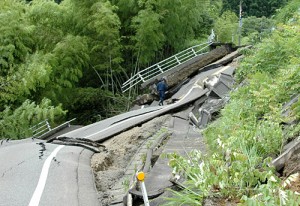Japan quake and tsunami
Coastal communities across east Asia were on alert for a possible tsunami in the wake of the major earthquake that struck Japan on Friday, with evacuations ordered in some parts of Taiwan, the Philippines and the Russian Far East.
In a bulletin at 8.30 am GMT, the Pacific Tsunami Warning Center in Hawaii said a widespread warning of potential wave damage was in effect from Russia to New Zealand, including many small Pacific island countries such as Tonga and Samoa.
The warning also extended to the west coast of the Americas, with countries from Mexico to Chile said by the US-funded centre to be at risk of potential ‘widespread damage’.
The first television pictures of the effects of the tsunami in Taiwan just before 10am GMT showed choppy waves rather than a wall of water. However, the warning centre said that tsunamis might consist of a series of waves that could batter coastlines for several hours, with the biggest waves possibly arriving some time after the first.
Indonesia, which had the coastline of its Aceh region devastated by a huge Indian Ocean tsunami in 2004, was braced for waves up to two metres high. Eastern provinces including Papua and the neighbouring independent state of Papua New Guinea were thought to be at most risk.
In Jakarta, citizens crowded around television screens to watch footage of events in Japan, many recalling the events of 2004, when more than 160.000 people died in Indonesia after a 9,1-magnitude earthquake hit off the coast of Sumatra.
Russian authorities on Friday evacuated some 11 000 residents from coastal areas on Pacific islands before they were hit by tsunami waves unleashed by a magnitude 8,9 earthquake off Japan’s northeastern coast.
The regional emergency officials said that the waves reached several towns and villages on the Kurils, four Pacific islands that the Soviet Union seized from Japan in the final days of the World War II, but caused no damage. The islands lie as close as six miles – 10 kilometres – from Japan’s Hokkaido island.
A three-meter wave reached the village of Malokurilskoye and some other villages recorded lower water levels, the Russian Emergency Situations Ministry said. There were no immediate reports of damage.
The Russian Defence Ministry said its facilities on the islands had suffered no damage.
The Russian State Fisheries Commmittee said that it had sent a tsunami warning to 76 fishing ships in the area – the ITAR-Tass news agency reported. It didn’t say if any of them sufffered any damage.
http://www.youtube.com/watch?v=kq1lzQ2xpv4
President Dmitry Medvedev on Friday offered Russia’s assistance to Tokyo following a huge earthquake and tsunami in Japan, as waves reached islands at the heart of the two countries’ territorial dispute.
“Of course we are ready to help our neighbours overcome the consequences of this very difficult earthquake” – Medvedev told a government meeting.
Earlier Friday, Russia declared a tsunami warning for the Kuril Island chain and ordered the evacuation of 11 000 people – officials said. The first tsunami waves reached the Kuril chain’s southernmost islands that are at the heart of Russia’s long-running territorial feud with Japan.
Russia’s territorial dispute with Japan surrounds the Kuril chain’s southernmost four islands (known in Russian as Iturup, Shikotan, Habomai and Kunashir) which are still claimed by Tokyo and collectively known in Japan as the Northern Territories.
The dispute has flared up since November when Medvedev paid an unexpected visit to one of the four islands, followed by a series of trips there by other top Kremlin officials.
